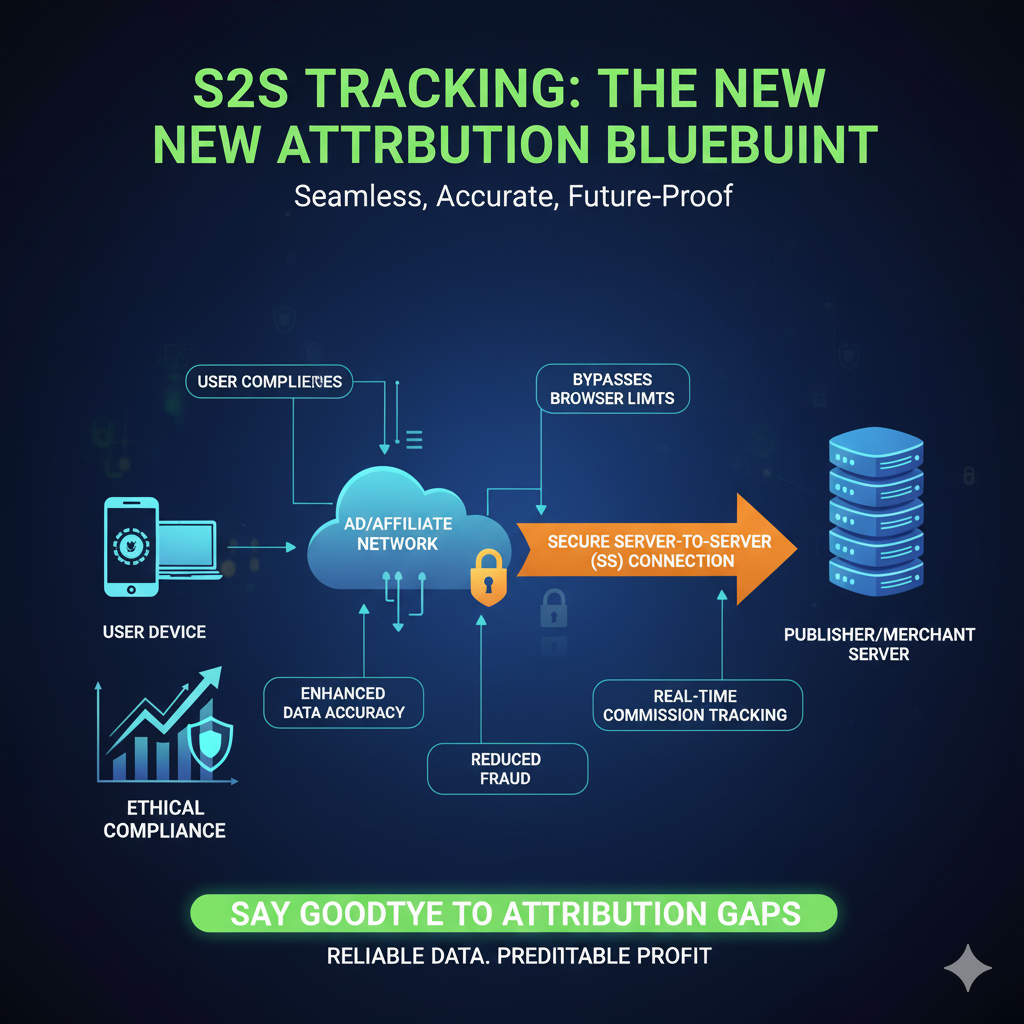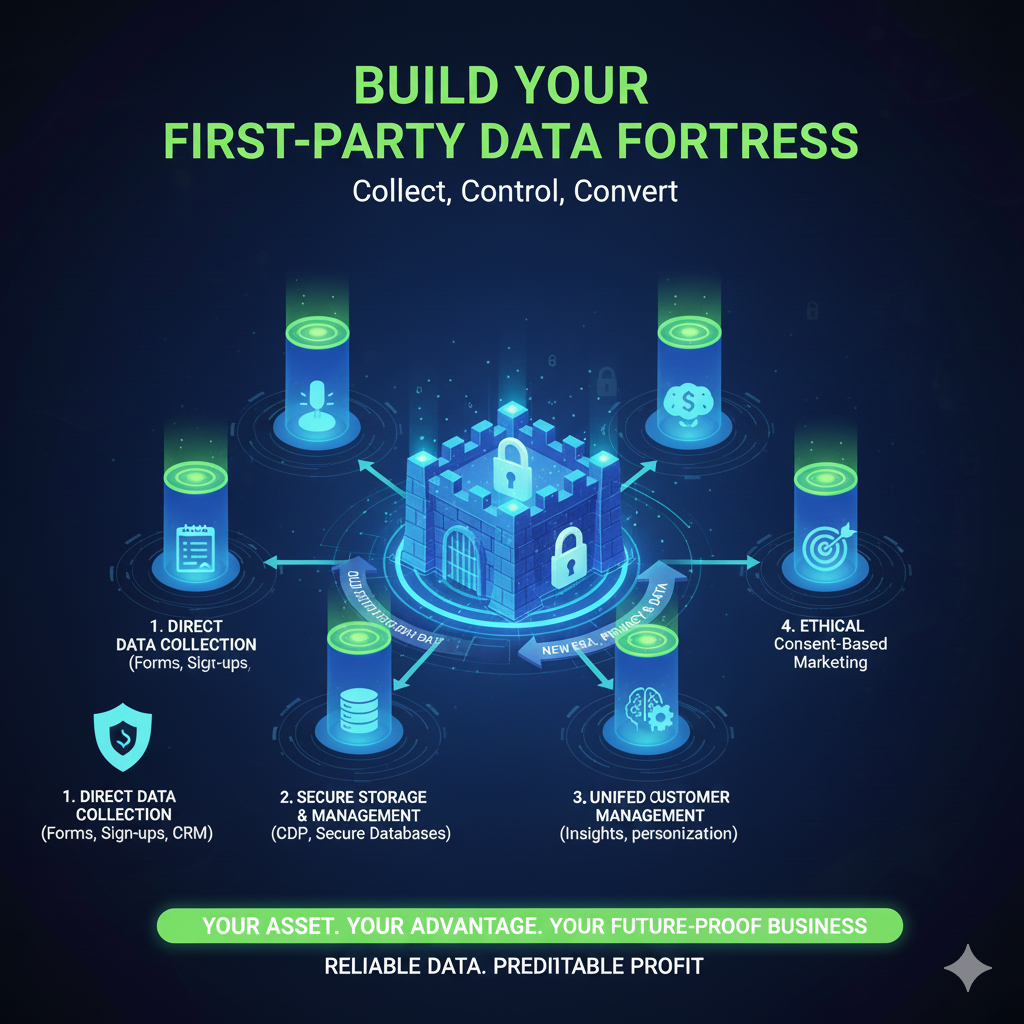
The digital landscape is undergoing a profound transformation, a shift so significant it rivals the birth of the internet itself. For affiliate marketers, this isn’t just a technical update; it’s a Great Reset [1].
The era of ubiquitous, invisible third-party tracking is ending, replaced by a new paradigm where user consent and data ethics are the non-negotiable currency. The keyword is clear: Privacy and Data Changes Impact [2].
But this impact is not a death knell; it is an evolutionary call. It’s a challenge to move from being a ‘digital opportunist’ to a ‘Digital Pioneer’—one who builds sustainable, trust-based relationships with their audience [3].
This comprehensive guide will dissect the major privacy shifts, analyze their direct impact on affiliate tracking and attribution, and, most importantly, provide a creative, actionable blueprint for thriving in the cookieless, privacy-first future.

The Three Pillars of the Privacy Revolution
To understand the current landscape, we must first recognize the three primary forces driving this revolution: Regulatory Mandates, Browser Blockades, and Platform Policy Shifts [4].
Pillar 1: The Regulatory Hammer (GDPR, CCPA, and Beyond)
Global legislation has set the legal foundation for data privacy. The European Union’s General Data Protection Regulation (GDPR) and California’s Consumer Privacy Act (CCPA) established the fundamental principle that consumers own their data [5].
These laws mandate explicit consent, transparency in data collection, and the right to be forgotten. For affiliate marketers, this means:
Explicit Consent: No more pre-checked boxes or vague privacy policies. Consent must be freely given, specific, informed, and unambiguous [6].
Disclosure: Affiliates must clearly and conspicuously disclose their relationship with the merchant, a requirement that goes beyond simple FTC guidelines and is now enforced by data protection authorities [7].
Data Minimization: Only collect the data absolutely necessary for the transaction. Excessive data collection is a liability, not an asset [8].
Pillar 2: The Browser Blockade (ITP and the End of Third-Party Cookies)
Technology companies, led by Apple and Google, are implementing changes directly within their browsers and operating systems to block cross-site tracking [9].
Apple’s Intelligent Tracking Prevention (ITP): Safari’s ITP has progressively limited the lifespan of cookies, especially third-party cookies, often reducing them to a mere 24 hours or less. This has severely hampered traditional affiliate tracking methods that rely on long look-back windows [10].
Google’s Privacy Sandbox: Chrome, the world’s most dominant browser, is phasing out third-party cookies entirely. Google is replacing them with a suite of privacy-preserving APIs (like Topics, FLEDGE, and Attribution Reporting) collectively known as the Privacy Sandbox [11].
The core message here is that the third-party cookie is dead. Affiliate tracking must evolve to rely on server-side, first-party, or privacy-preserving methods [12].
Pillar 3: The Platform Policy Shift (iOS 14.5 ATT)
Apple’s App Tracking Transparency (ATT) framework, introduced with iOS 14.5, requires apps to explicitly ask users for permission to track them across other apps and websites [13].
The vast majority of users opt out, leading to a massive reduction in the availability of device-level identifiers (like IDFA) for targeting and attribution [14].
While this primarily hit paid social media advertising, its ripple effect on affiliate marketing is profound: it has increased the value of affiliate marketing as a more reliable, performance-based channel that relies less on invasive tracking [15].
The Direct Impact on Affiliate Marketing: A Loss of Visibility
The collective force of these three pillars has created a single, critical problem for the traditional affiliate model: a loss of visibility [16].
Affiliate marketers are facing challenges in three key areas:
1. Attribution Gaps and Lost Commissions
When a user clicks an affiliate link on a mobile device (especially iOS) or a privacy-focused browser (like Safari), the cookie that tracks the click may expire before the user converts [17].
This leads to attribution gaps, where a sale occurs, but the affiliate is not credited, resulting in lost commissions and inaccurate performance data for the merchant [18].

2. Inaccurate Look-Back Windows
Many affiliate programs offer a 30-day or 60-day look-back window. With ITP and other browser restrictions, this window is often artificially shortened to 24 hours or less, making it impossible to track the full customer journey [19].
This penalizes affiliates who drive high-value, long-cycle conversions, such as those in the finance, B2B, or travel sectors [20].
3. Diminished Retargeting Capabilities
Affiliates often use pixel data to build retargeting audiences for their own marketing efforts. The decline of third-party cookies and the rise of ATT have made it significantly harder to build these high-quality, cross-site audiences [21].
This forces a strategic pivot away from relying on borrowed data (third-party) to focusing on owned data (first-party) [22].
The Creative Blueprint: Thriving in the Privacy-First Era
The solution is not to fight the tide of privacy but to ride it. The new era rewards affiliates who are technically savvy, audience-focused, and ethically transparent [23].
Here is the creative blueprint for the Digital Pioneer:
Strategy 1: Embrace Server-Side Tracking (The Technical Fix)
The most robust technical solution is to move tracking from the user’s browser (client-side) to your own server (server-side) [24].
How it Works: Instead of relying on a third-party cookie that can be blocked, the click is registered on your server first. Your server then communicates directly with the merchant’s server or the affiliate network’s server, passing the necessary tracking parameters without relying on the user’s browser [25].
Key Technologies:
First-Party Tracking: Using a custom subdomain (e.g., track.yourdomain.com) to set cookies that are treated as first-party by the browser, giving them a longer lifespan [26].
Server-Side Tagging (e.g., Google Tag Manager Server-Side): This allows you to control which data is sent and where it goes, ensuring compliance and maximizing attribution [27].
Affiliate Network Solutions: Many networks now offer server-to-server (S2S) tracking, often called Postback URLs or Conversion APIs. This is the gold standard for reliable, cookieless attribution [28].
Strategy 2: Build Your First-Party Data Fortress (The Audience Fix)
The most valuable asset in the privacy-first world is owned data—information you collect directly from your audience with their explicit consent [29].
This shifts the focus from tracking anonymous clicks to nurturing identifiable leads [30].
The Email List Renaissance: The email list is the ultimate first-party data asset. It is immune to browser blockades and platform policy changes. Affiliates must prioritize building a robust email list by offering high-value lead magnets [31].
The Content Upgrade Loop: Instead of a generic opt-in, offer content upgrades specific to the blog post (e.g., a “Checklist for Implementing S2S Tracking” within this post). This increases conversion rates and provides valuable segmentation data [32].

Zero-Party Data: This is data that a customer intentionally and proactively shares with you. Examples include survey responses, preference center selections, and quiz results. This data is incredibly valuable for hyper-personalization [33].
Strategy 3: Prioritize Contextual Relevance (The Content Fix)
In a world without precise behavioral targeting, the next best thing is contextual targeting [34].
This means placing the right affiliate offer within the most relevant content, relying on the user’s current intent rather than their past browsing history [35].
Deep Content Niches: Move away from broad topics. The more specific and problem-solving your content is, the higher the conversion rate will be, regardless of tracking limitations [36].
Intent-Based Linking: Ensure every affiliate link is a natural, helpful next step for the reader. If the content is about “The Best VPNs for Remote Workers,” the link should be to a VPN service, not a random product [37].
Affiliate Disclosure as a Trust Signal: Instead of hiding the disclosure, make it prominent and frame it as a benefit to the reader. “I only recommend products I genuinely use and trust. By purchasing through my link, you support this free content at no extra cost to you.” This builds trust, which is the ultimate conversion factor [38].
Navigating Google’s Privacy Sandbox: A New Attribution Model
Google’s initiative is the most complex challenge, as it aims to replace third-party cookies with a new set of APIs [39].
For affiliate marketers, the most critical component is the Attribution Reporting API [40].
This API allows for conversion measurement without identifying individual users across sites. It works by sending aggregated, privacy-preserving reports [41].
Key Takeaways for Affiliates:
Focus on Aggregated Data: You will receive less granular, individual user data. The focus shifts to understanding cohort performance and overall trends [42].
Embrace the “Fenced Frame”: Google is introducing technologies like Fenced Frames to isolate content and prevent cross-site tracking. Affiliates need to ensure their tracking solutions are compatible with these new embedding methods [43].
Partner with Networks: The complexity of integrating with the Privacy Sandbox APIs will likely fall to the major affiliate networks and tracking platforms. Choose a network that is actively investing in these cookieless solutions [44].
Deep Dive: Implementing Server-Side Tracking with Postback URLs
To bridge the attribution gap, the Digital Pioneer must master the implementation of Server-to-Server (S2S) tracking, also known as Postback URLs [50]. This method is the most reliable defense against browser-side tracking prevention [51].
The core concept is simple: instead of the user’s browser sending a cookie to the affiliate network, your server and the merchant’s server communicate directly [52].
The S2S Tracking Flow: A Step-by-Step Guide
Step 1: The Click ID Generation: When a user clicks your affiliate link, your tracking system (or the affiliate network) generates a unique identifier called a Click ID (or SubID) [53].
Step 2: Passing the Click ID: This Click ID is passed to the merchant’s website via the affiliate link. The merchant’s system must be configured to store this Click ID in their database alongside the user’s session [54].
Step 3: The Conversion Event: When the user completes a conversion (e.g., a purchase), the merchant’s server looks up the stored Click ID [55].
Step 4: The Postback: The merchant’s server then sends a secure, server-to-server request (the Postback URL) back to the affiliate network’s server. This request contains the Click ID and the conversion details (e.g., sale amount, commission) [56].
Step 5: Attribution: The affiliate network matches the received Click ID with the original click event, attributes the sale to you, and records the commission [57].
This entire process bypasses the user’s browser, making it immune to cookie expiration and ITP [58].
Technical Considerations for Affiliates
Custom Tracking Domains: Always use a custom tracking domain (e.g., go.yourdomain.com) to ensure that the initial click is treated as a first-party interaction, even if you are redirecting to an affiliate network [59].
Secure Connection (HTTPS): All S2S communication must be secured with HTTPS to maintain data integrity and trust [60].
Parameter Consistency: Ensure the parameter used to pass the Click ID (e.g., &subid=, &clickid=) is consistent across your tracking setup, the affiliate network, and the merchant’s system [61].
Case Study: The Rise of the Newsletter Affiliate
The shift to first-party data has created a massive opportunity for affiliates who focus on building a direct relationship with their audience [62]. The Newsletter Affiliate model is a prime example of a privacy-resilient strategy [63].

The Challenge: A traditional review site affiliate saw their conversion rates drop by 15% on iOS traffic after ATT was implemented, due to lost attribution [64].
The Pivot: They shifted their primary call-to-action (CTA) from “Click to Buy” to “Subscribe to Our Weekly Deal Digest” [65].
The Strategy:
High-Value Content: The blog posts became less about a hard sell and more about comprehensive product comparisons and educational content [66].
First-Party Data Collection: They used a two-step opt-in process to build a segmented email list. The list was segmented by product interest (e.g., “Software,” “Hardware,” “Finance”) [67].
Email-Based Attribution: Affiliate links were placed directly within the weekly newsletter. Since the user is already logged into their email client, the tracking is often more reliable, especially when combined with S2S tracking on the merchant side [68].
The Result: While blog traffic conversions initially dropped, the email list grew by 40% in six months. The overall revenue recovered and then surpassed the previous level because the email subscribers were a higher-quality, more loyal audience [69]. The revenue was more predictable and less vulnerable to external policy changes [70].
The Future is Ethical: Compliance as a Marketing Tool
Compliance is no longer a burden; it is a powerful marketing tool [71]. The ethical affiliate uses transparency to build a competitive moat of trust [72].
Beyond the Footer: Don’t bury your privacy policy and affiliate disclosure in the footer. Integrate them into the user experience [73].
The Trust Badge: Consider creating a “Privacy Promise” or “Data Ethics Badge” on your site. This simple visual cue signals to the user that you respect their data, which can be a significant differentiator in a crowded market [74].
The Zero-Party Data Exchange: Use quizzes, polls, and interactive tools to gather zero-party data. Frame this as a value exchange: “Tell us your biggest challenge, and we’ll recommend the perfect tool.” The user gets a personalized recommendation, and you get valuable, consented data [75].
The Privacy and Data Changes Impact has forced the industry to mature. The Digital Pioneer understands that the future of affiliate marketing is not about tracking every click; it’s about earning every click through genuine value and unwavering trust [76]. The Great Reset is an opportunity to build a better, more resilient business [77].

Final Frontier: Preparing for the Post-Cookie World
As we stand on the precipice of a truly cookieless internet, the final steps for the Digital Pioneer involve preparation and continuous adaptation [78]. The transition will not be instantaneous, but the groundwork must be laid today [79].
Audit Your Current Setup: The first action item is a comprehensive audit of your existing affiliate links and tracking mechanisms. Identify every link that relies solely on third-party cookies and prioritize them for migration to S2S or first-party methods [80].
Educate Your Partners: If you work with smaller merchants or networks, you may need to educate them on the necessity of S2S tracking. Frame it as a mutual benefit: better attribution for them means more reliable commissions for you, leading to higher motivation and more traffic [81].
Monitor the Privacy Sandbox: Google’s Privacy Sandbox is an evolving project. Stay informed about the latest developments, particularly the rollout of the Attribution Reporting API. While you may not need to integrate directly, understanding the capabilities and limitations will inform your content and promotion strategies [82].
The Privacy and Data Changes Impact has delivered a clear message: Adapt or become obsolete [83].
By embracing server-side tracking, building a first-party data fortress, and prioritizing ethical content, you are not just surviving the Great Reset—you are leading the charge into a more profitable and trustworthy future for affiliate marketing.
